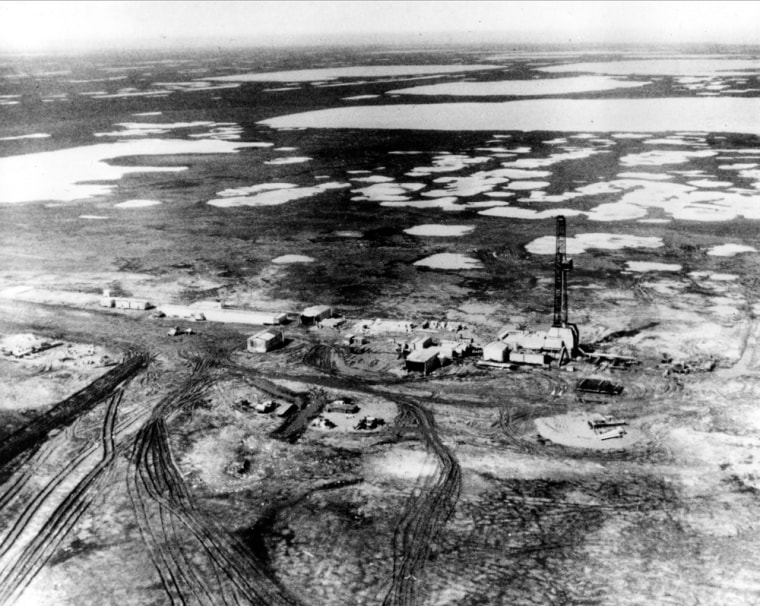Long before prospectors struck a huge store of oil on Alaska’s North Slope, seeps of the black gold were already noted by Inupiat Eskimos, and archaeological findings suggest oil shale was even used for fuel in the Arctic.
But it wasn’t until the discovery at Prudhoe Bay at the slope’s northeast corner that oil took on superstar status, launching an exploration frenzy in the harsh northernmost reaches of the young state.
After numerous wildcatters had hit several dry holes, they had all but given up until then-Atlantic Richfield Co. struck a vein the day after Christmas 1967, unleashing the thunderous roar of natural gas, according to “The Prize,” by Daniel Yergin.
Nine years after the discovery was announced in 1968, the nation’s largest oil field began production soon after the 800-mile trans-Alaska oil pipeline was constructed.
And this despite Prudhoe’s unforgiving remoteness, native rights claims and legal challenges by environmental groups that halted progress on the pipeline.
Alaska’s ‘anchor’
Ever since, Prudhoe Bay has been a major player in a state that receives 89 percent of its income from oil revenue. Even nearly two decades after its heyday, the field still brings the state more than $6 million daily in royalties and taxes.
“I would refer to it as the anchor field for the North Slope,” Pirtle Bates, deputy director of the state Division of Oil and Gas, said Thursday. “It provided for a majority of production and made it cost-effective to develop other fields there.”
British oil giant BP PLC was among the early stakeholders in Prudhoe Bay after it began scoping new stores of oil to reduce its dependence on Middle East sources. The company confirmed its own finding in 1969 after 10 years of preliminary exploration and millions spent on dry holes in Alaska.
That same year, BP and Atlantic Richfield — later known as Arco — agreed to jointly run the field, a relationship that would persist until BP acquired Arco in 2000, taking over as sole operator for several other owners.
Also in 1969, plans were unveiled to build the pipeline to carry the lucrative product from the tundra edging the Arctic Ocean south to the tidewater at Valdez in Prince William Sound, where it would be shipped primarily to domestic refineries.
Twenty years later, the oil tanker Exxon Valdez would run aground on Bligh Reef south of the Valdez port, pouring 11 million gallons of North Slope crude in the nation’s worst oil spill.
Oil boon winding down?
Alaska’s largest spill on the North Slope occurred in March at Prudhoe Bay when as much as 270,000 gallons leaked from a corroded transit pipe for days before it was seen oozing out of deep snow. It was a stark testament to the aging of the field and a precursor to BP’s announcement this week that it will temporarily shut it down because they found more transit pipeline corrosion.
“We were very disappointed by what we learned about the condition of the transit line,” said company spokesman Scott Dean. “We thought we had a very good corrosion and inspection program, but based on what we discovered last weekend, it’s simply not good enough. We’ll spare no expense to fix it.”
The shutdown occurs as Prudhoe Bay was producing 400,000 barrels of oil a day, about half the production on the North Slope. That’s a drastic drop from the boom times in the 1980s, when Prudhoe was producing 1.5 million barrels daily.
Since the first well was bored deep into the permafrost, Prudhoe Bay has yielded more than 10 billion barrels. BP officials say they believe at least another 3 billion barrels can be recovered altogether with improved technology — after replacement of 16 miles of transit pipelines, which carry market-ready oil to the trans-Alaska pipeline.
Prudhoe Bay is one of 13 fields BP operates in Alaska; it has a stake in three others operated by other companies.
“BP is approaching its 100th anniversary in two years — and over 40 years of its heritage has been involved in the oil and gas industry in Alaska,” Dean said. “Alaska is tremendously important to BP and we hope to be an active participant 40 years from now.”
